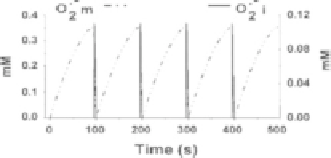Biology Reference
In-Depth Information
Experiment
Model
a
c
DDY
m
240
120
DY
m
NADH
200
80
160
40
120
0
80
d
NADH
9.0
40
8.7
0
8.4
0
200
400
600
800
b
8.1
200
7.8
dDCF/dt
0
100
200
300
400
500
e
150
100
50
0
200
400
600
800
Time (s)
Fig. 5.5 Dynamic behavior of energetic and redox variables during mitochondrial oscillations (a, b)
Shown is the simultaneous recording of the average whole-cell fluorescence of TMRE (a probe
of
ΔΨ
m
) and NADH (autofluorescence) (a), and the rate of ROS accumulation (first derivative,
dDCF/dt, of the CM-DCF signal) (b). (c-e) These
panels
display the simulation of the experimen-
tally observed oscillations in
m
,(c) NADH (d), and ROS (e, superoxide, O
2
.
, in the model)
with a mitochondrial oscillator model. The dashed lines are meant to emphasize the phase
relationship between the different signals in the experiment (a, b) and variables in the simulation
(c-e). Notice that, in the experiment as well as in the simulation, the peak in ROS accumulation
occurs concomitantly with
ΔΨ
m
depolarization and NADH oxidation during the initial phase
of the oscillation. The model simulation further shows that the spike of O
2
.
corresponds to
the release of the free radical accumulated in the mitochondrial matrix. Panels a, b were modified
from Aon, Cortassa, Marban, O'Rourke (2003) J Biol Chem 278, 44735-44. Panels c-e were
reproduced from Cortassa, Aon, Winslow, O'Rourke (2004) Biophys J 87, 2060-73
ΔΨ
According to the postulated mechanism, under oxidative stress, the enhanced
ROS production from the electron transport chain leads to accumulation in the
mitochondrial matrix to critical levels (Aon et al.
2003
,
2004a
), thereby triggering
the opening of IMAC in a positive feedback loop (Cortassa et al.
2004
). According
to this model, a burst in cytoplasmic ROS accompanies
ΔΨ
m
depolarization
(Fig.
5.5
) as a result of a mixed process of accelerated O
2
.
production occurring
concomitantly with a sudden increase in mitochondrial respiration. A pulse of
cytoplasmic O
2
.
is released (Aon et al.
2007a
; Cortassa et al.
2004
).
The mitochondrial oscillator behaves as a relaxation oscillator, composed of
both slow (ROS accumulation in the mitochondrial matrix) and fast (the IMAC
opening and rapid ROS release) processes (Fig.
5.5e
).


























































Search WWH ::

Custom Search